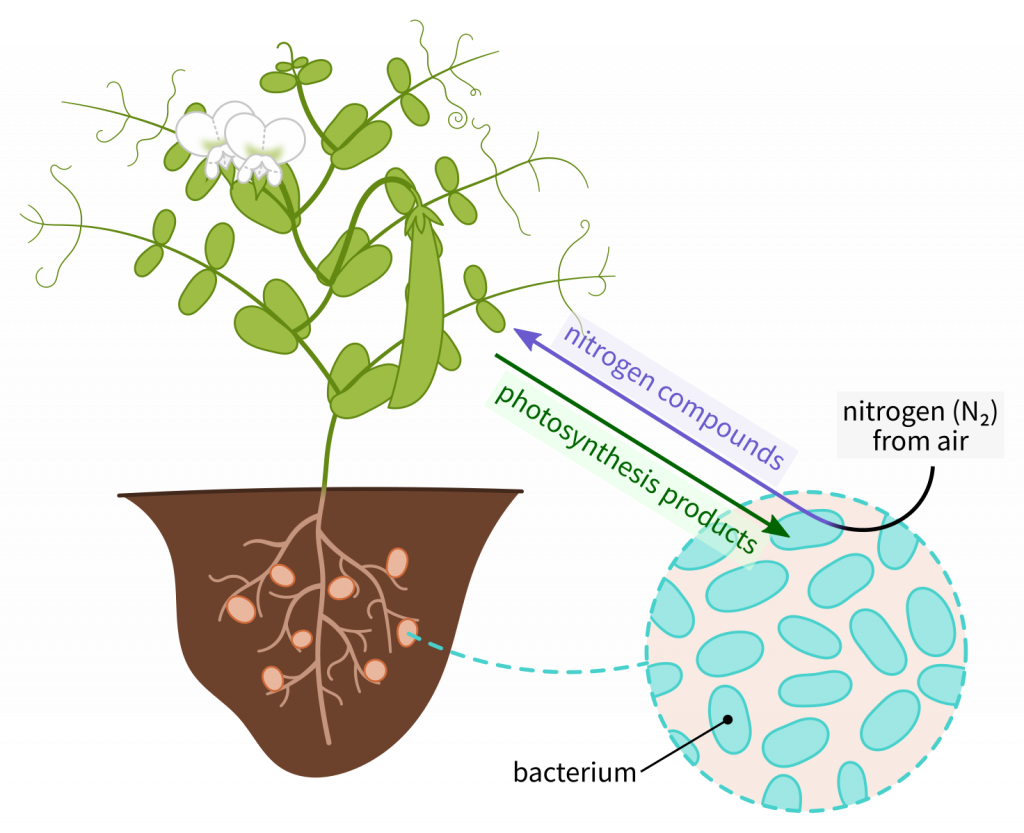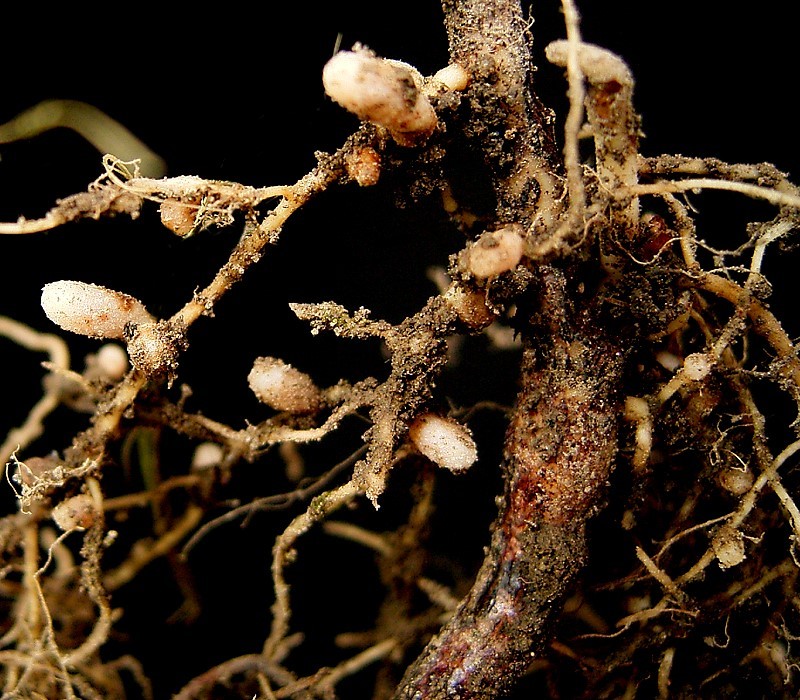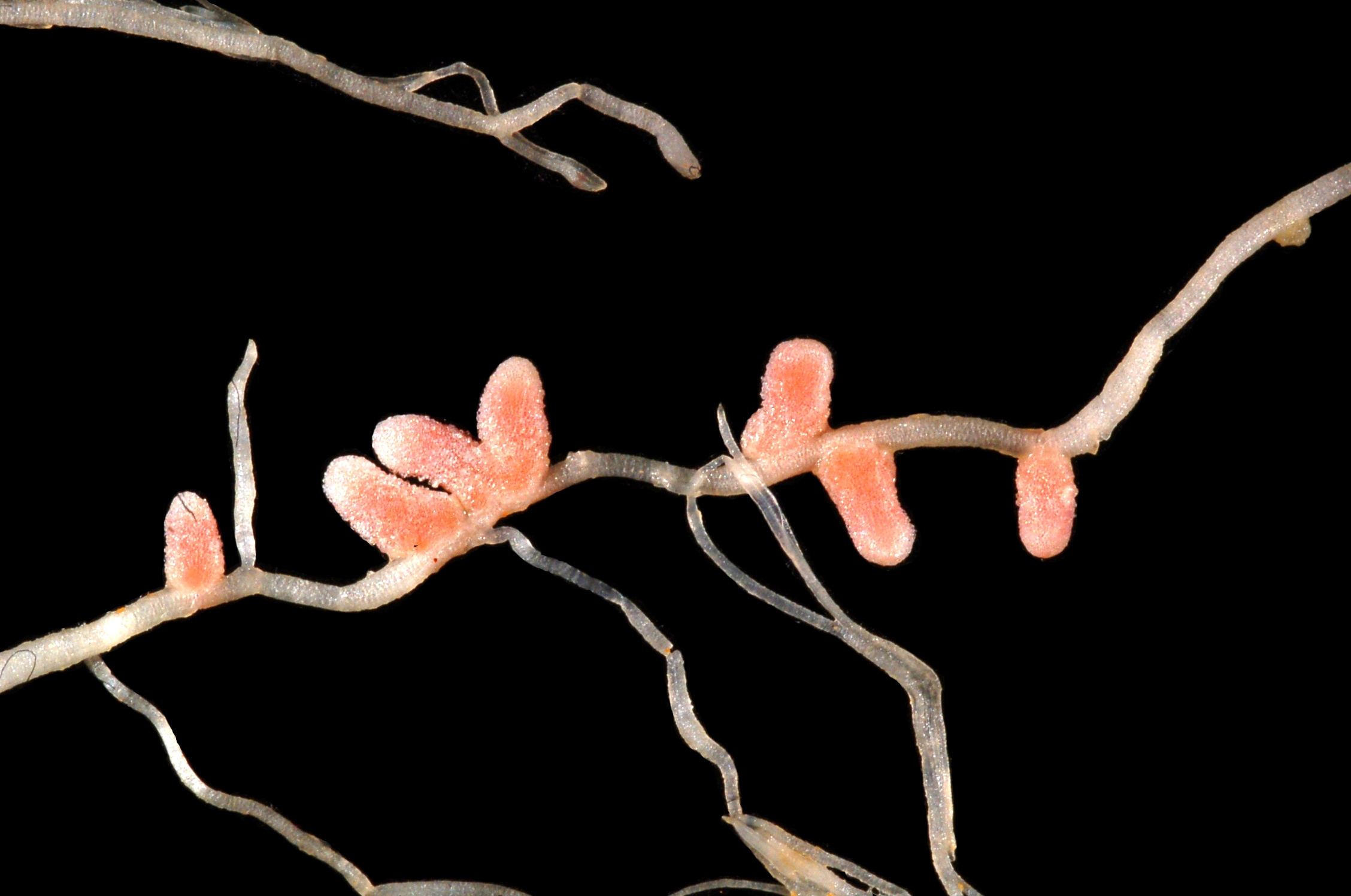2.42: Rhizobium- nitrogen fixing bacteria
- Page ID
- 70392
\( \newcommand{\vecs}[1]{\overset { \scriptstyle \rightharpoonup} {\mathbf{#1}} } \)
\( \newcommand{\vecd}[1]{\overset{-\!-\!\rightharpoonup}{\vphantom{a}\smash {#1}}} \)
\( \newcommand{\dsum}{\displaystyle\sum\limits} \)
\( \newcommand{\dint}{\displaystyle\int\limits} \)
\( \newcommand{\dlim}{\displaystyle\lim\limits} \)
\( \newcommand{\id}{\mathrm{id}}\) \( \newcommand{\Span}{\mathrm{span}}\)
( \newcommand{\kernel}{\mathrm{null}\,}\) \( \newcommand{\range}{\mathrm{range}\,}\)
\( \newcommand{\RealPart}{\mathrm{Re}}\) \( \newcommand{\ImaginaryPart}{\mathrm{Im}}\)
\( \newcommand{\Argument}{\mathrm{Arg}}\) \( \newcommand{\norm}[1]{\| #1 \|}\)
\( \newcommand{\inner}[2]{\langle #1, #2 \rangle}\)
\( \newcommand{\Span}{\mathrm{span}}\)
\( \newcommand{\id}{\mathrm{id}}\)
\( \newcommand{\Span}{\mathrm{span}}\)
\( \newcommand{\kernel}{\mathrm{null}\,}\)
\( \newcommand{\range}{\mathrm{range}\,}\)
\( \newcommand{\RealPart}{\mathrm{Re}}\)
\( \newcommand{\ImaginaryPart}{\mathrm{Im}}\)
\( \newcommand{\Argument}{\mathrm{Arg}}\)
\( \newcommand{\norm}[1]{\| #1 \|}\)
\( \newcommand{\inner}[2]{\langle #1, #2 \rangle}\)
\( \newcommand{\Span}{\mathrm{span}}\) \( \newcommand{\AA}{\unicode[.8,0]{x212B}}\)
\( \newcommand{\vectorA}[1]{\vec{#1}} % arrow\)
\( \newcommand{\vectorAt}[1]{\vec{\text{#1}}} % arrow\)
\( \newcommand{\vectorB}[1]{\overset { \scriptstyle \rightharpoonup} {\mathbf{#1}} } \)
\( \newcommand{\vectorC}[1]{\textbf{#1}} \)
\( \newcommand{\vectorD}[1]{\overrightarrow{#1}} \)
\( \newcommand{\vectorDt}[1]{\overrightarrow{\text{#1}}} \)
\( \newcommand{\vectE}[1]{\overset{-\!-\!\rightharpoonup}{\vphantom{a}\smash{\mathbf {#1}}}} \)
\( \newcommand{\vecs}[1]{\overset { \scriptstyle \rightharpoonup} {\mathbf{#1}} } \)
\( \newcommand{\vecd}[1]{\overset{-\!-\!\rightharpoonup}{\vphantom{a}\smash {#1}}} \)
\(\newcommand{\avec}{\mathbf a}\) \(\newcommand{\bvec}{\mathbf b}\) \(\newcommand{\cvec}{\mathbf c}\) \(\newcommand{\dvec}{\mathbf d}\) \(\newcommand{\dtil}{\widetilde{\mathbf d}}\) \(\newcommand{\evec}{\mathbf e}\) \(\newcommand{\fvec}{\mathbf f}\) \(\newcommand{\nvec}{\mathbf n}\) \(\newcommand{\pvec}{\mathbf p}\) \(\newcommand{\qvec}{\mathbf q}\) \(\newcommand{\svec}{\mathbf s}\) \(\newcommand{\tvec}{\mathbf t}\) \(\newcommand{\uvec}{\mathbf u}\) \(\newcommand{\vvec}{\mathbf v}\) \(\newcommand{\wvec}{\mathbf w}\) \(\newcommand{\xvec}{\mathbf x}\) \(\newcommand{\yvec}{\mathbf y}\) \(\newcommand{\zvec}{\mathbf z}\) \(\newcommand{\rvec}{\mathbf r}\) \(\newcommand{\mvec}{\mathbf m}\) \(\newcommand{\zerovec}{\mathbf 0}\) \(\newcommand{\onevec}{\mathbf 1}\) \(\newcommand{\real}{\mathbb R}\) \(\newcommand{\twovec}[2]{\left[\begin{array}{r}#1 \\ #2 \end{array}\right]}\) \(\newcommand{\ctwovec}[2]{\left[\begin{array}{c}#1 \\ #2 \end{array}\right]}\) \(\newcommand{\threevec}[3]{\left[\begin{array}{r}#1 \\ #2 \\ #3 \end{array}\right]}\) \(\newcommand{\cthreevec}[3]{\left[\begin{array}{c}#1 \\ #2 \\ #3 \end{array}\right]}\) \(\newcommand{\fourvec}[4]{\left[\begin{array}{r}#1 \\ #2 \\ #3 \\ #4 \end{array}\right]}\) \(\newcommand{\cfourvec}[4]{\left[\begin{array}{c}#1 \\ #2 \\ #3 \\ #4 \end{array}\right]}\) \(\newcommand{\fivevec}[5]{\left[\begin{array}{r}#1 \\ #2 \\ #3 \\ #4 \\ #5 \\ \end{array}\right]}\) \(\newcommand{\cfivevec}[5]{\left[\begin{array}{c}#1 \\ #2 \\ #3 \\ #4 \\ #5 \\ \end{array}\right]}\) \(\newcommand{\mattwo}[4]{\left[\begin{array}{rr}#1 \amp #2 \\ #3 \amp #4 \\ \end{array}\right]}\) \(\newcommand{\laspan}[1]{\text{Span}\{#1\}}\) \(\newcommand{\bcal}{\cal B}\) \(\newcommand{\ccal}{\cal C}\) \(\newcommand{\scal}{\cal S}\) \(\newcommand{\wcal}{\cal W}\) \(\newcommand{\ecal}{\cal E}\) \(\newcommand{\coords}[2]{\left\{#1\right\}_{#2}}\) \(\newcommand{\gray}[1]{\color{gray}{#1}}\) \(\newcommand{\lgray}[1]{\color{lightgray}{#1}}\) \(\newcommand{\rank}{\operatorname{rank}}\) \(\newcommand{\row}{\text{Row}}\) \(\newcommand{\col}{\text{Col}}\) \(\renewcommand{\row}{\text{Row}}\) \(\newcommand{\nul}{\text{Nul}}\) \(\newcommand{\var}{\text{Var}}\) \(\newcommand{\corr}{\text{corr}}\) \(\newcommand{\len}[1]{\left|#1\right|}\) \(\newcommand{\bbar}{\overline{\bvec}}\) \(\newcommand{\bhat}{\widehat{\bvec}}\) \(\newcommand{\bperp}{\bvec^\perp}\) \(\newcommand{\xhat}{\widehat{\xvec}}\) \(\newcommand{\vhat}{\widehat{\vvec}}\) \(\newcommand{\uhat}{\widehat{\uvec}}\) \(\newcommand{\what}{\widehat{\wvec}}\) \(\newcommand{\Sighat}{\widehat{\Sigma}}\) \(\newcommand{\lt}{<}\) \(\newcommand{\gt}{>}\) \(\newcommand{\amp}{&}\) \(\definecolor{fillinmathshade}{gray}{0.9}\)
Rhizobiaare one of several group of bacteria capable of 'fixing' nitrogen, i.e. converting dinitrogen gas into ammonia and then into organic molecules such as amino acids. Because of this ability, nitrogen fixing bacteria are significant conduits between an extremely large pool of nitrogen in the atmosphere and living things who otherwise could only obtain nitrogen by recycling it from existing pools of organic nitrogen(e.g. amino acids, ammonia, nitrate and nitrite). Unlike many nitrogen fixing bacteria that can fix nitrogen when 'free-living' (i.e. when not living inside a host plant) Rhizobiacan only fix nitrogen when associated with a plant that provides it with carbohydrates. The carbohydratesprovide energy for a process that requires substantial inputs of energy (both ATP and the reducing power of NADH). Rhizobiaonly associate with legumes, members of the pea family. (But not all legumes associate with Rhizobiaand somethat have nitrogen fixing associates may have bacteria other thanRhizobia).
Taxonomy and Phylogeny

Rhizobia are members of the Domain Bacteria. They are gram negative bacteria that are usually flagellated and motile. The ability to associate with legumes, like the ability to fix nitrogen, is NOT thought to be significant phylogenetically. The ability to fix nitrogen appears to have evolved separately several times (i.e. convergent evolution) as evidenced by its presence in Archaea, Cyanobacteria (see Nostoc ) and several other bacterial groups not phylogenetically related. Similarly, t he ability to associate with legumes (which might be considered a type of parasitism) is thought to have been transferred horizontally and consequently is not a good indicator of phylogeny (which reflects vertical gene transfer). The Rhizobia group is thus considered to be paraphyletic.
Structure
Rhizobia are rod shaped bacteria, 0.8 um in diameter and 2 um in length, often with flagellae. They assumea different shape when inside their host, being irregularly shapedandoften 'Y' -shaped.Their presence induces a novel structure within root hair cells called an infection thread. Sensing the presence of Rhizobia, root hairs curl and bacteria are lodged in the crook of the curl. At this point the root cell wall is degraded and the bacteria proliferate in a space outside the root hair cell membrane. A tubular infection thread is then produced and grows down the root hair into the root itself. The thread has cell wall materials and essentially is an elongate invagination of the cell wall, with materials contributed both by the plant and by the bacteria. The infection thread eventually fuses with cell membrane at its base, adjacent to the root cortex. The infection thread then extends to enter (infect) cortical cells, inside of which the bacteria proliferate. As the thread develops the cortical cells have de-differentiated and have become meristematic, producing the tumor (nodule) that characterizes Rhizobiuminfection of roots.
Sex and reproduction
Like all bacteria, Rhizobia are not sexual but they are capable of exchanging genetic material by other means.
Matter and energy
Rhizobiaare heterotrophs that are capable of associating with photosynthetic plants that will provide them with carbohydrates ( 'food' ) as well as whatever nutrients (i.e. mineral elements) they need, excluding the nitrogen which they obtain from the air, where it is abundant. Particularly important to the nitrogen fixation process is the element molybdenum. When Rhizobiaare living outside of a plant they are typical heterotrophs feeding on dead organic material and use the material obtained both as 'building material' for growth and to provide substrates that are oxidized in cellular respiration to provide energy.
Interactions

The ability to associate with legumes requires elaborate communication (signaling) between Rhizobiumand its host plant. Factors secreted by both the plant and the bacteria affect the gene expression and behavior of the other. Among other features, the cells of the gall producea form of hemoglobin called leghemoglobin that is able to bind oxygen and thereby reduce the levels of free oxygen, which is a poison to the nitrogen fixation process. Nodules develop vascular connections, allowing the nodules to be 'fed' with carbohydrates produced by the host plant. These are used primarily to power the substantial energy demands of the nitrogen fixation process but also provide carbohydrate molecules to which the fixed nitrogen is attached. The bacteria acquire N2and excrete ammoniathat is incorporated by the host plant into organic acids forming amino acids or other nitrogen containing compounds. There are forms of Rhizobiathat are complete parasites, being fed by the plant but providing no fixed nitrogen.


